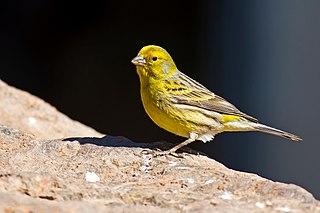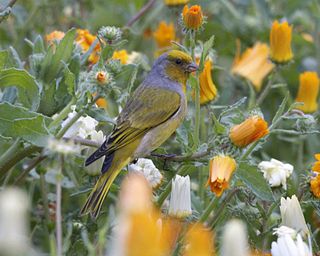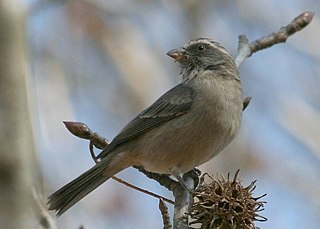
The Atlantic canary, known worldwide simply as the wild canary and also called the island canary, common canary, or canary, is a small passerine bird belonging to the genus Serinus in the finch family, Fringillidae. It is native to the Canary Islands, the Azores, and Madeira. Wild birds are mostly yellow-green, with brownish streaking on the back. The species is common in captivity and a number of colour varieties have been bred.

The common chaffinch or simply the chaffinch is a common and widespread small passerine bird in the finch family. The male is brightly coloured with a blue-grey cap and rust-red underparts. The female is much duller in colouring, but both sexes have two contrasting white wing bars and white sides to the tail. The male bird has a strong voice and sings from exposed perches to attract a mate.

The Eurasian siskin is a small passerine bird in the finch family Fringillidae. It is also called the European siskin, common siskin or just siskin. Other (archaic) names include black-headed goldfinch, barley bird and aberdevine. It is very common throughout Europe and Eurosiberia. It is found in forested areas, both coniferous and mixed woodland where it feeds on seeds of all kinds, especially of alder and conifers.

The European serin, or simply the serin, is the smallest European species of the family of finches (Fringillidae) and is closely related to the Atlantic canary. Its diet consists mainly of a combination of buds and seeds.

Audubon's warbler is a small bird of the Parulidae family.

Wilson's plover is a small bird of the family Charadriidae.

The yellow-fronted canary , also called the yellow-eyed canary, is a small passerine bird in the finch family. It is known elsewhere and in aviculture as the green singing finch.

The chestnut-bellied sandgrouse or common sandgrouse is a species of sandgrouse. It is a sedentary and nomadic species that ranges from northern and central Africa and further east towards western and southern Asia. There are six recognised subspecies.

The Cape canary is a small passerine bird in the finch family. It is a resident breeder in southern Africa and has been introduced to Mauritius and Réunion.

The yellow canary is a small passerine bird in the finch family. It is a resident breeder in much of the western and central regions of southern Africa and has been introduced to Ascension and St Helena islands.

The streaky-headed seedeater or streaky-headed canary is a small passerine bird in the finch family. It is a common resident breeder in suitable habitats in southern Africa.

The Cape siskin is a small passerine bird in the finch family. It is an endemic resident breeder in the southern Cape Province of South Africa.

The brimstone canary or bully canary is a small passerine bird in the finch family. It is a resident breeder in central and southern Africa.

The protea canary, also known as the protea seedeater, white-winged seedeater or Layard's seedeater, is a small passerine bird in the finch family.

The Drakensberg siskin is a small passerine bird in the finch family. It is an endemic resident breeder in the eastern Cape Province Transkei and western Natal in South Africa, and in Lesotho.

The black-headed canary is a species of finch found in Lesotho, Namibia and South Africa. It is sometimes placed in the genus Alario as Alario alario

The lemon-breasted canary, also known as the lemon-breasted seedeater, is a species of finch in the family Fringillidae. It is found in Malawi, Mozambique, South Africa, Zambia, and Zimbabwe. Its natural habitats are dry savannah, subtropical or tropical dry shrubland, and rural gardens.

The Tibetan serin or Tibetan siskin is a true finch species.

Crithagra is a genus of small passerine birds in the finch family (Fringillidae). They live in Africa and Arabia.



















